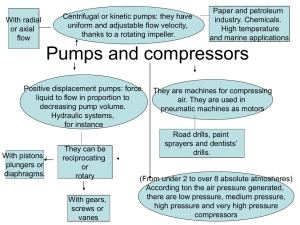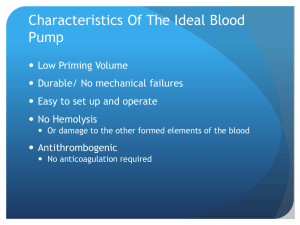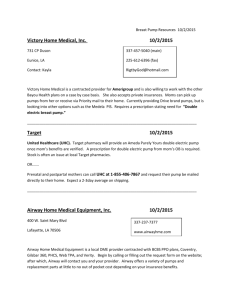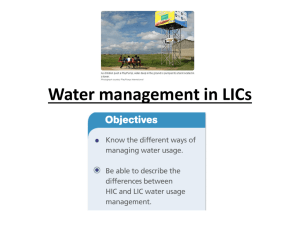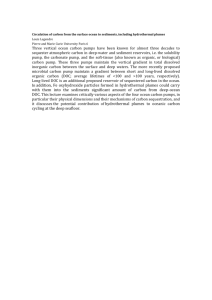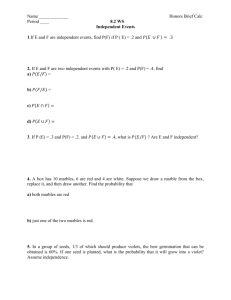Oil & Gas Industry Report - Peerless Pump XNET Home
advertisement
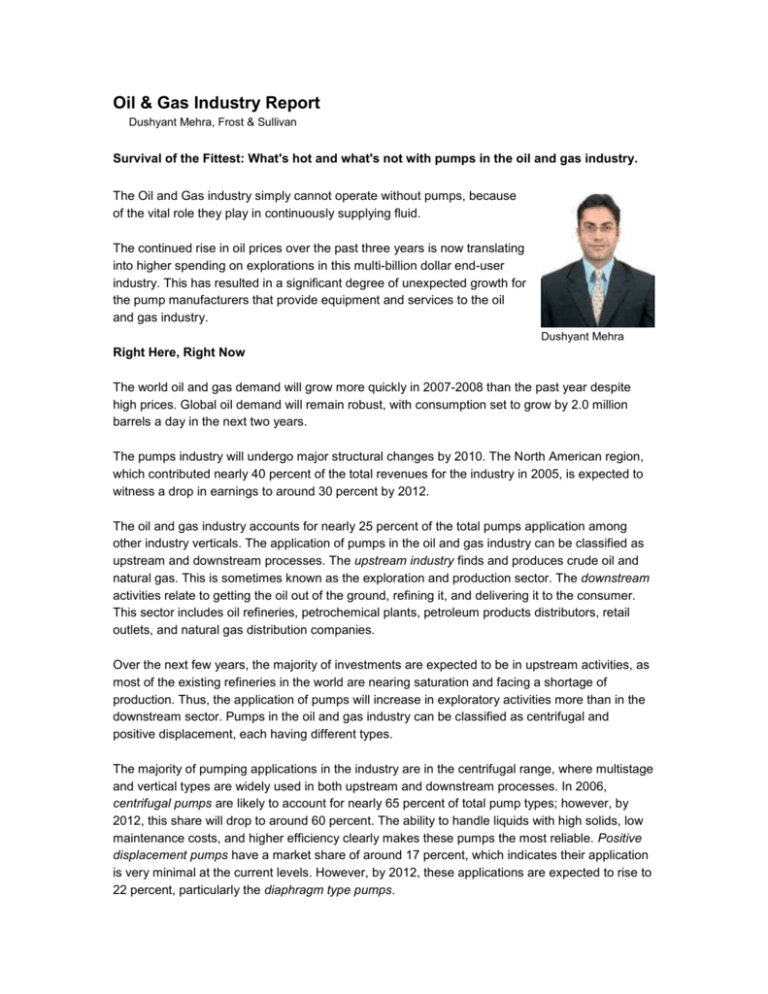
Oil & Gas Industry Report Dushyant Mehra, Frost & Sullivan Survival of the Fittest: What's hot and what's not with pumps in the oil and gas industry. The Oil and Gas industry simply cannot operate without pumps, because of the vital role they play in continuously supplying fluid. The continued rise in oil prices over the past three years is now translating into higher spending on explorations in this multi-billion dollar end-user industry. This has resulted in a significant degree of unexpected growth for the pump manufacturers that provide equipment and services to the oil and gas industry. Dushyant Mehra Right Here, Right Now The world oil and gas demand will grow more quickly in 2007-2008 than the past year despite high prices. Global oil demand will remain robust, with consumption set to grow by 2.0 million barrels a day in the next two years. The pumps industry will undergo major structural changes by 2010. The North American region, which contributed nearly 40 percent of the total revenues for the industry in 2005, is expected to witness a drop in earnings to around 30 percent by 2012. The oil and gas industry accounts for nearly 25 percent of the total pumps application among other industry verticals. The application of pumps in the oil and gas industry can be classified as upstream and downstream processes. The upstream industry finds and produces crude oil and natural gas. This is sometimes known as the exploration and production sector. The downstream activities relate to getting the oil out of the ground, refining it, and delivering it to the consumer. This sector includes oil refineries, petrochemical plants, petroleum products distributors, retail outlets, and natural gas distribution companies. Over the next few years, the majority of investments are expected to be in upstream activities, as most of the existing refineries in the world are nearing saturation and facing a shortage of production. Thus, the application of pumps will increase in exploratory activities more than in the downstream sector. Pumps in the oil and gas industry can be classified as centrifugal and positive displacement, each having different types. The majority of pumping applications in the industry are in the centrifugal range, where multistage and vertical types are widely used in both upstream and downstream processes. In 2006, centrifugal pumps are likely to account for nearly 65 percent of total pump types; however, by 2012, this share will drop to around 60 percent. The ability to handle liquids with high solids, low maintenance costs, and higher efficiency clearly makes these pumps the most reliable. Positive displacement pumps have a market share of around 17 percent, which indicates their application is very minimal at the current levels. However, by 2012, these applications are expected to rise to 22 percent, particularly the diaphragm type pumps. Road Ahead: Key Challenges The pumps market is highly fragmented, with the top 20 market participants having 80 percent of the market share. The primary challenge for pump manufacturers is to improve the energy costs and efficiency of their pumps. Regulations regarding energy consumption are most likely to get stricter in the next two to three years. Other important considerations for manufacturers are producing better lifecycle costs for equipment and providing full global support services to end users along with products. The rate of investments in R&D and exploratory projects have become stagnant in North America and Europe, and it is essential that market participants take the initiative to develop innovative technologies and take advantage of the growth opportunities. Smart Moves: Emerging Trends China is the fastest growing market for pumps in the oil and gas sector. The growth rate in the Asia Pacific region will be twice that of the total market. Emerging markets for pump manufactures would be in Russia, Brazil, Mexico, Kazakhstan, Venezuela, Vietnam, and Canada, as they will witness high rate of investments in upstream processes by 2012. These are the few countries having surplus crude production, together with an abundance of natural resources. Improved technology and reservoir management will allow for sustained growth in global oil production sufficient to meeting the rising demand. The power and wastewater sectors in particular will have a strong demand for pumps. Rising concern over the energy consumption will give way to increased use of variable speed drives to monitor the flow of fluid, which will in turn improve effectiveness and efficiency in the coming years. M & A Partnerships The consolidation trend in the industry will continue, wherein end users will benefit as the focus is shifting on providing more solution-based and full support services, rather than just the product itself. Companies prefer to go for smaller acquisitions to enhance their technology, product and solutions portfolio, and talent pool. It will be profitable for top manufactures to acquire small companies with an efficient technology instead of developing the technology on their own. Some notable acquisitions in this industry are as follows: Sulzer Pumps Ltd. (Winterthur, Switzerland) acquired Johnson and Crown Pumps as part of its increased effort to widen the product profile and adopt technological know-how. Grundfos Management A/S (Bjerringbro, Denmark) recently signed an agreement to acquire the Swedish producer of customized prefabricated pump pits, Wage Industry AB, catering to the wastewater market. Grundfos sees the acquisition as part of its increased focus in the wastewater sector, where it is essential to be able to offer system solutions. The trend towards acquisitions and partnerships is most likely to continue until 2012 and the market will be dominated by fewer participants as it requires huge investments. The big companies will get bigger and the smaller will disappear. Moreover, mergers and acquisitions are a common phenomenon in most industries today, with every company wanting to survive and have a larger share of the pie. Table 1 shows the revenue forecast for the total pumps market in the oil and gas industry (global) for the period 2002-2012. The total pumps market in the oil and gas sector generated revenues of $5,232.2 million in 2005. The initial years of the forecast period will see a steady growth in revenue growth rate, due to the key market challenges that pump manufacturers Table 1 are faced with, including high energy costs, the need to provide solutions and full support services, and the maturity of the market. The North American market has been witnessing a stagnant growth rate that has negatively affected the investment in upstream processes in the region, as no new refineries have come up. Revenue growth during the forecast period (2006-2012) will be primarily due to the continuous rise in demand for oil and gas, leading to increased pump application in the upstream processes in search for new oil fields, and the growing demand from emerging economies in Latin America and the Asia Pacific region. Furthermore, stricter regulations, the need to improve efficiency and productivity, and replacement of aging equipment should all serve pump manufacturers to upgrade their equipment and processes, thus aiding future demand and revenue growth. Revenues are expected to reach $8,016.2 million in 2012 at a CAGR of 6.3 percent. Conclusion The pumps market in the oil and gas industry experienced a growth rate of 5.5 percent in 2005. The market continues to be mature and is dependent on the emerging economies, which in turn are driving the growth with new discoveries and exploratory activities in the pipeline. It is, however, expected that the industry is likely to witness an increase in capital expenditure in the upstream processes through the forecast period 2006 to 2012, mainly driven by higher energy and life cycle costs, which are the focus areas for customers. This, in turn, poses a key challenge to most pump manufacturers to produce highly efficient and affordable pumps. Furthermore, centrifugal pump types, which are widely used in both upstream and downstream processes, are expected to see a larger demand, especially in the Latin American and Asia Pacific regions where major exploratory activities are likely to happen. The Asia Pacific region, mainly India and China, is projected to contribute a major portion of revenues due to factors such as high economic growth and increasing industrialization, coupled with burgeoning population growth. Major market participants have established strong dealer networks across diverse geographic regions. The limited number of oil reserves and increasing energy requirements across the globe has led to spiraling of prices, resulting in supply-related concerns for countries around the world. Although every participant wishes to be a part of this competitive market, the survival is privileged only for the fittest. Dushyant Mehra is a research analyst with Frost & Sullivan, 7550 IH 10 West, Suite 400, San Antonio, TX 78229-5616, 877-463-7678, Fax: 888-690-3329, www.frost.com.
